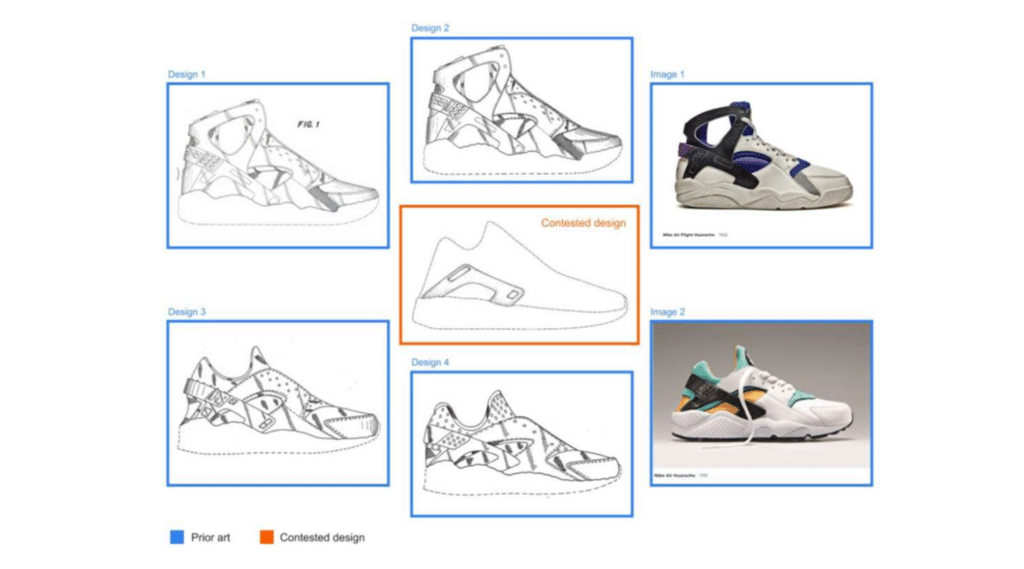In a decision that underscores the complexities of design protection in the fashion and footwear industries, the Cancellation Division of the European Union Intellectual Property Office (“EUIPO”) has handed Nike Innovate C.V. (“Nike”) a loss in a clash over one of its footwear designs. In a decision on January 24, the EUIPO invalidated one of the American sportswear giant’s registered Community designs following a challenge initiated by Alfredo Langella, an Italian designer, who successfully argued that Nike’s design lacks the necessary individual character required for protection under EU law.
At the heart of the invalidation proceeding was Nike’s Registered Community Design No. 003400472-0001 (the “contested design”), which was issued back in 2016 for a specific footwear upper element of Nike’s Air Huarache Run Ultra sneaker, described as a lateral strap-like component forming an inverted “C” shape. Nike’s contested design was registered by the EUIPO in September 2016 with priority claimed from a U.S. design patent (No. D802,280) for the “ornamental design of a shoe upper” as embodied in Air Huarache Run Ultra.

Langella challenged the validity of Nike’s design on the basis of Article 25(1)(b) of the Community Design Regulation (“CDR”), arguing that the design lacked the required “individual character” under Article 6(1)(b) CDR. Specifically, in his bid to invalidate Nike’s design protection, Langella maintained that the design is substantially similar to a design patent that was issued to Nike in the U.S. in 1992 (No. D330,452) for its Nike Air Flight Huarache sneaker. Langella argued that the differences between Nike’s contested design and the prior art are insignificant and that the differences amount to mere technical adaptations rather than novel creative elements.
Nike countered Langella’s claims by emphasizing that the footwear industry is highly saturated with competitive designs, making it so that even minor details in design elements are distinguishable to informed consumers. “The category of products concerned would be that of footwear uppers and sneakers for sports and outdoor life, which is a highly crowded market,” Nike argued, pointing to prior decisions from the EUIPO that confirm that “minor differences” between “footwear [designs] and their parts” are enough to give rise to “individual character” in those designs.

Additionally, Nike argued that its prior design covered an entire upper, whereas the contested design consists of a distinct lateral element with a minimalistic aesthetic.
A Market, Footwear Analysis
In furtherance of its assessment of the parties’ respective arguments, the EUIPO applied the following four-step analysis …
> The Sector Concerned & the Informed User: The EUIPO confirmed that the contested design falls within the footwear industry. As for the “informed user” (which is significant, as under EU design law, a design is considered to have “individual character” if the overall impression it produces on the “informed user” differs from the overall impression produced by the prior art), the EUIPO found that this is “a person who is familiar with the shoes and boots, their uppers and upper parts that were available on the market during the relevant period … mainly because of their own experience or interest in these products.”
> Designer’s Degree of Freedom: The EUIPO determined that Nike’s designers had a “high degree of [creative] freedom … when creating parts of shoe and boot uppers and their decorative elements,” making the burden of differentiation even higher.
> Disclosure of Prior Art: The tribunal confirmed that the prior design has been publicly available since at least 1992, satisfying the disclosure requirement.
> The Overall Impression: The EUIPO found that the core shape of the contested design – an inverted “C” or boomerang-like element – is highly similar to the prior design, with minor differences that fail to create a distinct overall impression.
Ultimately, the EUIPO determined that the contested design does not present the requisite level of uniqueness to warrant protection, thereby, rendering it invalid.

TLDR: “It is concluded, from the standpoint of the informed user, and taking into account the designer’s freedom in the contested design and the other circumstances of the case as set out above, that the overall impression conveyed by the contested design does not differ from that conveyed by the prior design. As a result, the contested design lacks individual character within the meaning of Article 6(1)(b) CDR.”
Implications for Nike & the Industry
Nike’s loss before the Cancellation Division (which can – and likely will – be appealed to the EUIPO Board of Appeal) highlights the ongoing challenges brands face in securing and maintaining design rights in an increasingly competitive market. The ruling reinforces the importance of demonstrating a clear departure from prior art when seeking design protection, particularly in industries with extensive design histories. Moreover, this decision could have broader ramifications beyond Nike. Fashion and footwear companies, alike, frequently rely on design registrations to shield their products from knockoffs.
Given that many companies routinely introduce new iterations of staple sneaker designs (New Balance’s 990 is a good example of this) and with the EUIPO signaling a stringent stance on what constitutes individual character, brands may need to rethink their design – and design registration – strategies to ensure that each new iteration is sufficiently distinct from prior works.











